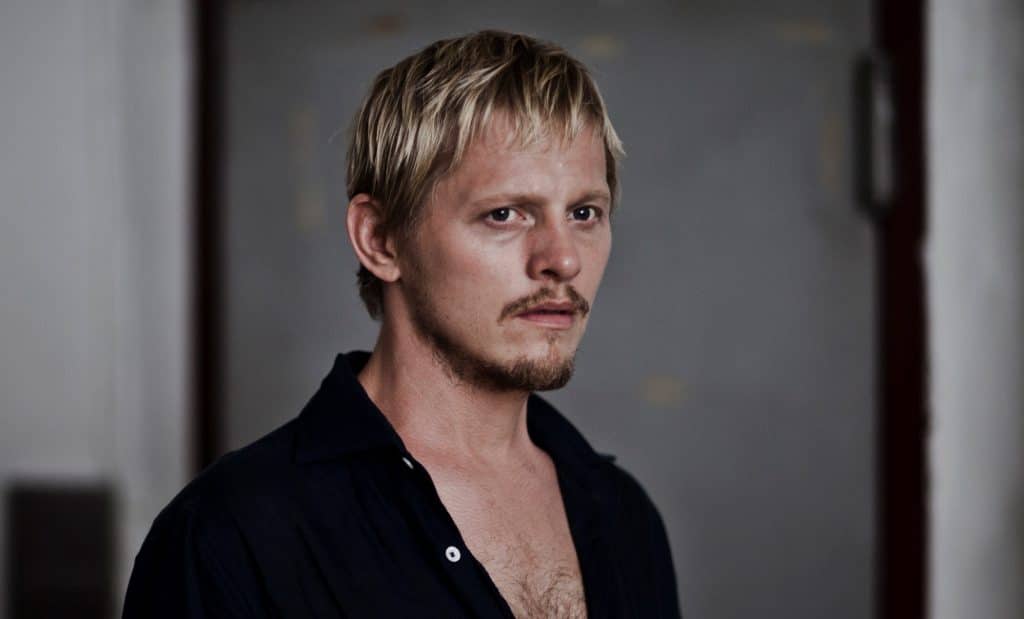Keep the Lights On is brutally honest and devastating like love can be when ruined by drug addiction and by one person’s dependence on another
Keep the Lights On (2012)
Directed by Ira Sachs. Written by Ira Sachs and Mauricio Zacharias. Starring Thure Lindhardt, Zachary Booth, Julianne Nicholson, Souleymane Sy Savane, Paprika Steen, Miguel del Toro, Sebastian La Cause, David Anzuelo, Maria Dizzia, Justin Reinsilber and Ed Vassallo.
When Keep the Lights On begins, the year is 1998 and we see Erik (Thure Lindhardt) lying in his bed in a dimly lit room looking for someone on a phone sex hotline. It is a perfect opening scene that illustrates what the film wants to do, showing a gay man trying to find some connection in a city like New York. After a few frustrated attempts, Erik leaves to meet a guy he just spoke with and walks to his place to the sound of a dissonant minimalist viola that seems to translate his state of mind. It is as if the instrument is also looking for a song. When Erik enters Paul’s (Zachary Booth) apartment, they don’t exchange a word and jump straight to the kissing. No need to waste time when they both know what they want.
Keep the Lights On is in essence a film about strangers, about people we get to know — or think we know enough — but always find a way to surprise us (for better or worse). Erik is a Danish filmmaker working on a documentary about little-known gay artist Avery Willard, and Paul is a lawyer in the publishing industry. They feel strongly attracted to each other, and while Paul initially has a girlfriend (“don’t get your hopes up,” he warns Erik), soon he breaks up with her and the two men move in together. But Paul also has a drug problem, which begins to create fissures in their relationship when his behavior becomes increasingly erratic and he even disappears for days without telling where he is.
What director Ira Sachs does here is tell us about his own long-term relationship with Bill Clegg, a literary agent who has published a memoir detailing his addiction to crack cocaine (and this film is based on it). Along nine years of the characters’ relationship, we follow how addiction can slowly destroy what two people have together, growing from something that seems harmless at first to a very serious issue. We see, for instance, how Paul’s libido decreases when he is not on drugs, or how Erik mistakes acceptance for permissiveness, taking a lot more from Paul than most people could endure and trying to be some kind of savior to a boyfriend who is clearly dissatisfied with what they have.
Thus, it is only natural that their relationship turns into a source of suffering for both. Without seeming to realize the pattern he follows, looking for the same person in every new boyfriend (even the name Paul is a variation of his last one’s, Paolo), Erik adopts a nearly stoic attitude, at some point even physically hurting himself as a cry of despair in a destructive relationship. Lindhardt’s performance is intense, while Sachs is smart to emphasize Erik’s dissatisfaction by framing him in corners and piercing the film’s yellow cinematography with blue details that become more and more pronounced. Later on, the blue takes over when we witness an extremely depressing scene involving a male prostitute in a hotel room.
It may be hard for some viewers to believe that anyone can be so passive when in love — and I’ve heard people complain that the film is unrealistic — but what makes Keep the Lights On so honest is how it depicts Erik’s gradual realization that he is stuck in an unhealthy relationship. At a certain moment, Paul even notices that their apartment floor is buckling, in an intelligent representation of what is happening to them. When Erik points out to an assistant that there is something that needs to be fixed in the documentary, he is told that they can fix it later — which illustrates his own attitude towards Paul, since he refuses to face the elephant in the room and seems to believe that the two can work out their problems in bed.
Sachs also understands what it is like to feel at home with someone, even as you realize that that person has always been a stranger in your life. “You smell like you,” Paul says in one of the most revealing scenes in the film. Nothing can be as sad as the realization that things are so wrecked between two people that they cannot be mended anymore. In the end, when Erik is forced into a decision, he is first seen bathed in yellow in the shower, but then, as he is unable to sleep, there is blue everywhere in the bathroom and we know what this means. I also love the green light that combines both colors when Erik and Paul meet at the staircase of Paul’s place — and notice how Paul wears a yellow T‑shirt and Erik is dressed in blue in this scene.
Reaching a conclusion that impresses for its maturity — especially as the dissonant sounds of Arthur Russell’s voice and viola finally seem to find a song (“Every step is moving me up,” he sings) — Keep the Lights On is the kind of gay-themed drama that is becoming increasingly rare nowadays: one that is brutally honest and devastating like love can be when ruined by addiction and by one person’s dependence on another.





